Lisa Sachs's Blog
May 23, 2019
E Pluribus Unum, 2019
The Skokie Festival of Cultures
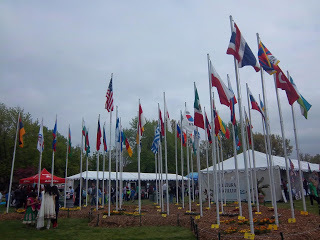
Growing up in New York, one of my favorite activities was visiting the United Nations. I loved watching the Security Council meetings or any other meetings so that I could press the buttons on the headphones to hear people speaking in all the official U.N. languages. There were six buttons – for English, French, Spanish, Russian, Chinese, and the language of whoever was speaking. Even though I didn’t know the other languages, I loved hearing the sounds of people speaking them. It was music to my ears.
Now that I’m an adult and living in Skokie-Evanston, Illinois, I no longer have to press buttons. All I have to do is attend the Skokie Festival of Cultures. This year was the Festival’s 29th. This year’s theme was music. People from 38 countries had organizations participating in the Festival.
We were there for the opening ceremonies. People marched with their flags from Armenia, Assyria, Azerbaijan, Bangladesh, Belize, Bulgaria, Cambodia, the Cameroons, People’s Republic of China, Chinese Republic of China, Circassia, Croatia, Cuba, Estonia, the Filipines, Finland, Greece, India, Iraq, Ireland, Israel, Jamaica, Japan, South Korea, Laos, Lithuania, Luxembourg, Mexico, Norway, Pakistan, Russia, Sweden, Thailand, Tibet, Turkey, the United States, and Uzbekistan.
When each one came to the stage, “Welcome to the Skokie Festival of Cultures” was said in that language and a few bars of their music was played. When they were finished, we all sang the “Star Spangled Banner” together and said the Pledge of Allegiance. It is on our currency E Pluribus Unum. From many one. The anthem and pledge reminded us all of our origins as immigrants. It is always a joy to watch things going right. I wished that I could invite the rest of the United States to see how it’s done.
After the opening ceremonies, we went to see the booths of each country to admire their crafts and talk to the people there. Where else can someone meet people from all these countries in less than an hour?
We were going to return to the outdoor venue to watch the different groups dance their dances or sing their songs. Unfortunately, the sky darkened and rain was imminent. We went indoors to see some other performances. Humanity followed us in from the four corners of the world. Together we watched dancers from Arabia, Japan, and Uzbekistan. Outside, the rain came down in torrents and we almost needed to build another Ark to get home. The dancers were beautiful. Despite the deluge, the day was a ray of sunshine.
Some pictures taken during the Festival of Cultures:
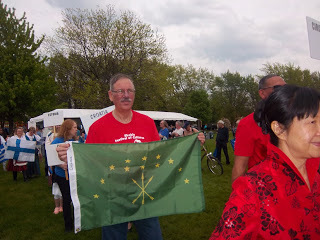
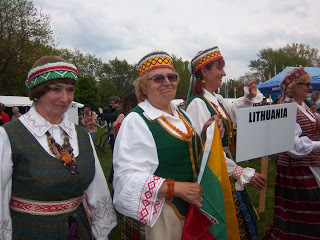

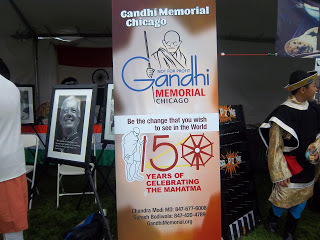
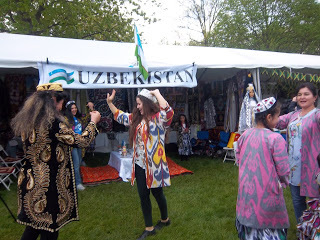
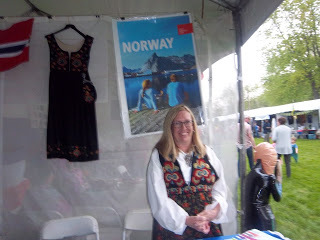
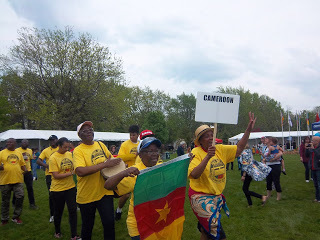
Published on May 23, 2019 06:00
April 11, 2019
Three Perfect Days in Savannah, Georgia
We had come from Chicago where it was much too cold to Panama City, Panama where it was much too hot. Then on the way home from Florida, we stopped in Savannah where the weather was just right. We arrived in Savannah in the middle of March. The azaleas were in bloom and the temperatures were in the 70’s with no rain.
Usually, when we go to another city, we have a few places that we plan to see. This time, however, we were content to just walk around this beautiful city. I had heard that Savannah was nice but it exceeded either of our expectations. The historic district is divided into twenty-four districts each one with a square. This was the original plan for Savannah when it was established in 1733. Each square has many very mature trees providing beautiful shade. With the azaleas and other flowers in bloom, each square was exquisite.
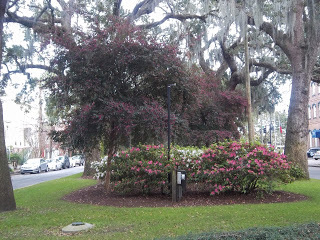

As if that wasn’t enough, the architecture of Savannah is wonderfully preserved from this time period. The beautiful cobble stoned streets and vintage buildings are great to see. The Savannah College of Art and Design (SCAD) is a major part of the city and it has a lot of influence on the city’s current development. SCAD has a museum which we heard was wonderful but we didn’t get to visit it this time.
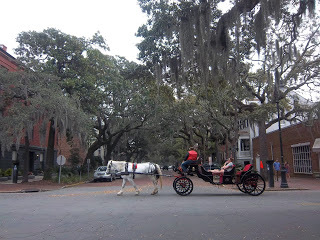
We did have time to go to the City Market Art Center where we met some very talented artists and artisans. Their studios were open and we were lucky to meet them. Jerry Taylor’s shop had many beautiful prints and she talked to us about her work. It was evident that she is very dedicated to it. She has painted much of the Gullah culture, former slaves from many African cultures that live on the barrier islands. Gullah is the dialect that they evolved to be able to communicate with one another across many tribal languages. I couldn’t resist buying a print.
 artist Jerry Taylor in her studioNext, we visited with Diane at Diane’s knitting studio. Besides making beautiful knit hats and scarves, she has classes where she teaches young people how to knit. In addition to her work, she sells earrings left to her by her late husband. Some of these are really special and I had to buy a pair.
artist Jerry Taylor in her studioNext, we visited with Diane at Diane’s knitting studio. Besides making beautiful knit hats and scarves, she has classes where she teaches young people how to knit. In addition to her work, she sells earrings left to her by her late husband. Some of these are really special and I had to buy a pair.
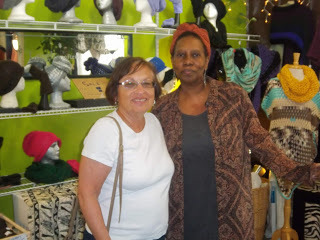 Diane and me in her knitting studioAs we walked around Savannah’s beautiful streets, we were reminded that two very accomplished women lived there. One was the short story writer Flannery O’Connor. Her acerbic style is unique and I’d enjoyed reading some of her short stories. The tour of her childhood home, which takes about an hour, was very enjoyable.
Diane and me in her knitting studioAs we walked around Savannah’s beautiful streets, we were reminded that two very accomplished women lived there. One was the short story writer Flannery O’Connor. Her acerbic style is unique and I’d enjoyed reading some of her short stories. The tour of her childhood home, which takes about an hour, was very enjoyable.
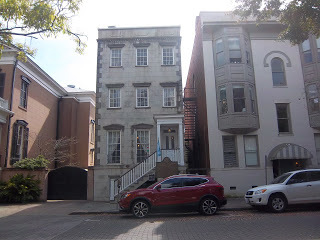 childhood home of Flannery O'ConnorBeing in Savannah on the weekend, we saw many groups of girls wearing their green Girl Scout uniforms. They were there to pay homage to the founder of American Girl Scouting. I had forgotten that Juliette Gordon Low grew up in Savannah. I wanted to visit her childhood home but the tours were sold out. We did get to see the outside of her house. Since I’d been a Brownie and then a Girl Scout, that was very exciting. On our next visit, we’ll have to take the tour. I am all ready to go back there.
childhood home of Flannery O'ConnorBeing in Savannah on the weekend, we saw many groups of girls wearing their green Girl Scout uniforms. They were there to pay homage to the founder of American Girl Scouting. I had forgotten that Juliette Gordon Low grew up in Savannah. I wanted to visit her childhood home but the tours were sold out. We did get to see the outside of her house. Since I’d been a Brownie and then a Girl Scout, that was very exciting. On our next visit, we’ll have to take the tour. I am all ready to go back there.
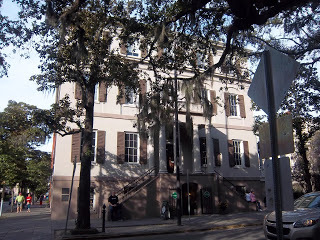 childhood home of Juliette Gordon Low
childhood home of Juliette Gordon Low
Published on April 11, 2019 06:00
April 4, 2019
Minority Life in Panama
One thing I love to do when visiting another country is to see how people in various small groups and minorities are living. In Panama, it was interesting to learn that the Chinese have had a presence there for about 150 years. The main times we met them was at the various convenience stores which the Chinese own. The Jews also have a population in Panama of about 13,000 mostly in Panama City. We were able to attend Shabbat services at the Reform Synagogue there and were happy to see their community thriving.
The largest minority ethnic group is what they call “Afro-Antilleanos" - people of African ancestry who had come to Panama from various Caribbean islands. About 15% of the Panamanian population is considered to be of African descent and at least 50% of Panamanians have some African ancestry.
One of the best sites to learn about the history of this interesting group is the Afro-Antilleano Museum in Panama City. This small museum right across the street from the Plaza de Mayo subway stop is housed in a former church. Its exhibit is small – you can view their exhibit in a half hour to an hour – but very informative.
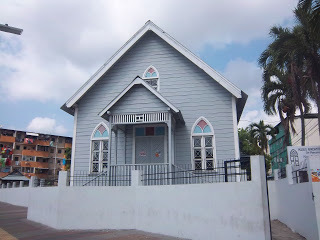
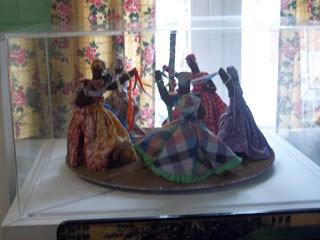 At the Afro-Antilleano Museum
At the Afro-Antilleano MuseumAfricans came to Panama in two waves. They were first brought as slaves by the Spaniards in 1513 and for years after. The second wave was from 1844 – 1910 when they were recruited to Panama to work on building the railroad and the Panama Canal. After the Canal was completed, the people were expected to return to their Caribbean Islands. Instead many stayed in Panama and a large group still lives in what had been the Canal Zone. They also live in neighborhoods of Panama City, Portobello, and some inland towns near the Chagres River where they continue to work as farmers. We passed the field in the Canal Zone where Rod Carew first started his baseball career on the way out of Panama City when we left for Portobello.
In the beginning, Portobello was an important port. We were lucky to meet friends Sholem and Bienvenida who took us to visit this interesting town. Near Colon on the Caribbean side of Panama it is the home of many Afro-Antilleanos today. This town is famous for its festival every October honoring the Black Jesus. It was interesting to walk in the shadows of this town and see the people living there.
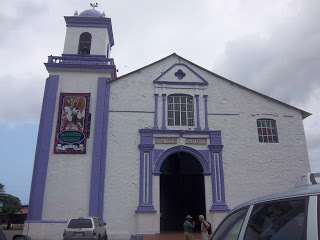 In Portobello
In Portobello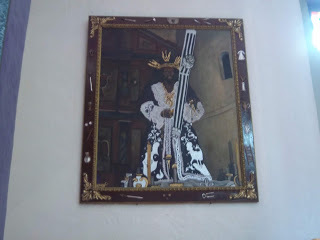
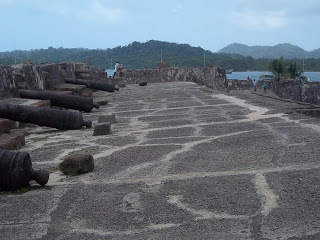 the ruins in Portobello, the first main port in Panama
the ruins in Portobello, the first main port in PanamaOn our last weekend in Panama City, we attended the annual Afro-Antilleano Fair. The fair seemed to parallel the general Carnival that also took place that weekend. A queen and two princesses are crowned. The array of colorful clothes that the women wore was really fun to see. Art and artisan work are displayed for people to buy and a delicious array of food was available. The aromas were so tempting that I wished that I could try all of it.
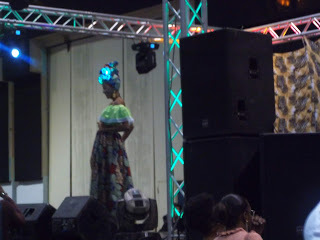
A big part of both fairs was the crowning of the queen and princesses which seemed to delight the people there but it appeared to us that women's aspirations there lagged behind in consciousness. We weren’t in Panama long enough to find out if having two fairs is because of racial discrimination or a desire to preserve the Antilleano culture. Perhaps we need to make another trip there to find out. In the meantime, we felt fortunate to have met some of the people who shared this interesting history.
Published on April 04, 2019 06:00
March 28, 2019
Panama, the Center of the Americas
We had never met anyone in the United States from Panama and that piqued our interest to go there. We’d be assured of hot weather when everyone in Chicago was suffering in the Polar Vortex. We’d heard about Coronado Beach and besides, the Panama Canal is a wonder of the world, an engineering feat fascinating to see.
We arrived in Panama on February 4th in time to avoid a lot of horrendous Chicago weather and to enjoy Panama’s dry season. Cruising the Canal is a must. Standing in the middle of the Americas, the Canal has changed the history of our hemisphere connecting us all in many ways. It’s advisable to book a boat cruise on the Panama Canal on-line before you go there. You won’t want to miss it.
The histories of Panama and the United States and the rest of the Americas are intertwined because of the Canal. The day before going on the Panama Canal cruise, we visited the Museum of the Panama Canal in Casco Viejo. This museum rolls out the history of the Canal from the beginnings of its construction to the United States’ handing control of it to Panama. Captions are in both Spanish and English.
The Canal was built by the United States and until 1999, was controlled by it. Because the area around the Canal - the Canal Zone - was also controlled by the United States, our influence is felt there even now in much larger proportion than in other parts of Central America. For a long time, the Panamanians, viewing U.S. control of the Canal Zone as colonialism, had demanded that the Canal and the Canal Zone be handed back to them. In 1977, President Jimmy Carter and Omar Torrijos, then President of Panama, negotiated the return of the Canal to Panama to be final in 1999.
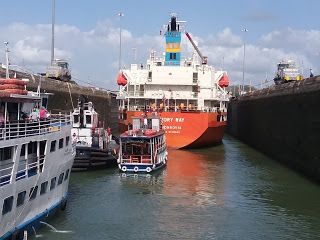
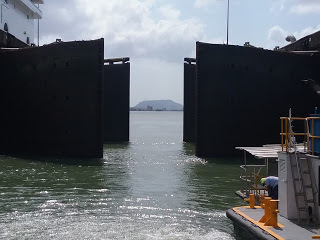
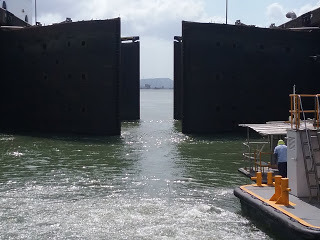
Since the return of the Canal to Panama, Panama City has boomed, growing exponentially into one of over a million people with no apparent thought to urban planning. The income inequality is blatant. Yet,this city’s mushrooming in just over twenty years’ time is fascinating to see. The car traffic is impossible. Many high rises loom leaving little room for green space.
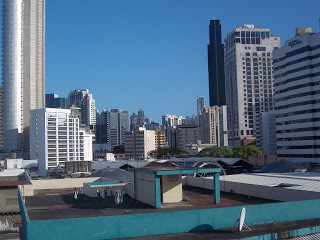
Many North Americans go there because it has modern conveniences and infrastructure. Their WIFI connections are great. You can drink the water. And violent crime is at a minimum. Their subway system is new and immaculate. I have to add that the people who ride it are extremely courteous offering both of us seats every time they saw us standing.
American chain stores and megamalls that put the Mall of America in Minneapolis to shame abound there. At the Albrook Mall, one can see every American chain store and fast food restaurant imaginable. While it’s debatable whether or not this is the aspect of our culture we want to export, it’s there for better or worse. Since it’s so hot in Panama City – usually in the 90’s Fahrenheit with high humidity, we went there a few times to be in air-conditioning, to walk, and to meet friends for lunch or to get buses to other parts of Panama. While the influence of America is there, you can still see many women dressed in traditional indigenous garb going there to shop. I found these contradictions fascinating.
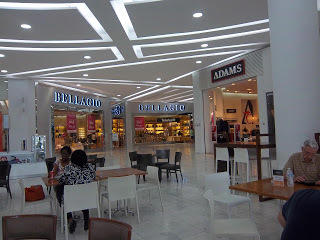
Try Panama. It stands at the center of the Americas and as such has always been a crossroads. It’s a great place to start any exploration of the our hemisphere.
Published on March 28, 2019 06:00
March 21, 2019
Montgomery, Alabama - The Last Stop of Our Trip and the First Step on our Way Home
The first Civil Rights protest that I was aware of was the Montgomery Bus Boycott in 1956. I was eight years old when this event took place. It would be surprising except that it was extremely powerful seeing an entire community walking, carpooling, and taking cabs demanding that Jim Crow bus laws be ended. That the community sustained that effort for a year is something I’ll remember forever. Thus when we were invited by Pat Thornton at the Southern Poverty Law Center to tour their offices in Montgomery, I got the goose pimples. It’s hard to believe that 63 years have gone by since Rosa Parks’ arrest for refusing to give up her seat on the bus to a white man. It’s even more surprising how few people remember or are aware of that pivotal moment that galvanized the Civil Rights Movement.
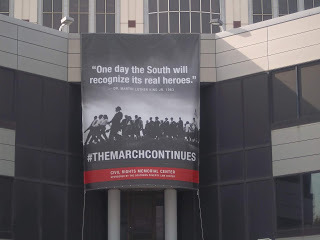
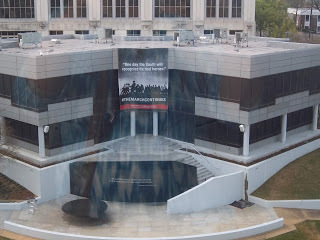 the view from the windows of the SPLC officesWe arrived in Montgomery in early March at the end of a long trip to points south. The Southern Poverty Law Center, founded by Morris Dees, Julian Bond, Joe Levin, and Joseph J Levin Jr in 1971, was our first stop there. Its mission is to provide legal services and advocacy to insure the rights of all vulnerable groups in the United States. Their legal division takes mostly class action - ones that will the protect rights of people in vulnerable groups. Defending the rights of racial minorities, religious minorities, immigrants, the disabled, the LGBTQ community, they stand as a buffer between all of us and those forces that seek to eradicate all the progress that has been made since the 1950’s.
the view from the windows of the SPLC officesWe arrived in Montgomery in early March at the end of a long trip to points south. The Southern Poverty Law Center, founded by Morris Dees, Julian Bond, Joe Levin, and Joseph J Levin Jr in 1971, was our first stop there. Its mission is to provide legal services and advocacy to insure the rights of all vulnerable groups in the United States. Their legal division takes mostly class action - ones that will the protect rights of people in vulnerable groups. Defending the rights of racial minorities, religious minorities, immigrants, the disabled, the LGBTQ community, they stand as a buffer between all of us and those forces that seek to eradicate all the progress that has been made since the 1950’s.We toured their floor where diligent people monitor the proliferation of on-line hate groups that have mushroomed since November, 2016. We also saw their program Teaching Tolerance which provides educational resources and materials for educators. Most of the material is free to teachers. Their resources that teach tolerance for every grade level can be used to teach core curriculum. Every teacher would be wise to request this information. They can inquire about it at the SPLC’s website https://www.splcenter.org.
After touring the SPLC offices, we went across the street to the new civil rights memorial. This powerful memorial pays tribute to all the people who lost their lives advocating for equal rights. At the beginning of the exhibit, is a short video talking about all the sacrifices. A class of fourth grade students was there watching this video with us and we were glad to know that this history is taught to all fourth graders in Alabama.
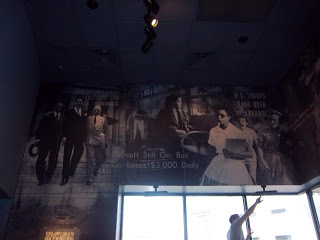
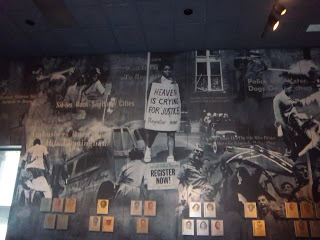 posters seen at the Civil Rights MemorialOn our way out of the museum, we talked to people working in the gift shop and asked if things were still better than before. One woman assured us that it is. “It’s much better than the way it was for my parents,” she said. “We have a black police chief, sheriff, and fire chief.”
posters seen at the Civil Rights MemorialOn our way out of the museum, we talked to people working in the gift shop and asked if things were still better than before. One woman assured us that it is. “It’s much better than the way it was for my parents,” she said. “We have a black police chief, sheriff, and fire chief.”I only hope that they can hold on to progress made. To give ourselves inspiration, we went around the corner to The Dexter Avenue Memorial Baptist Church where Martin Luther King led much of the Civil Rights Movement.
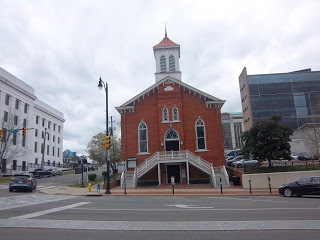 Dexter Avenue Memorial Baptist ChurchThere is still so much work left to do and this stop was a great one to make on our way home to Chicago from South Florida. Ready to resume taking part in efforts to create a just society, this was the perfect last stop on our way home.
Dexter Avenue Memorial Baptist ChurchThere is still so much work left to do and this stop was a great one to make on our way home to Chicago from South Florida. Ready to resume taking part in efforts to create a just society, this was the perfect last stop on our way home.
The work of the SPLC is more urgent now than ever. If you would like to donate money to them, you can check out their website https://www.splcenter.org .
Published on March 21, 2019 06:00
October 30, 2018
In Tragedy, the United States Joins the Rest of the World
In 2008 when we entered the synagogue in Florence, Italy we had to go through a metal detector. The people there were grateful that their synagogue was again in use as a place of worship, as a community center, and as a Jewish Museum.
When we went to the main synagogue and Jewish Museum in Buenos Aires in 2012, we were buzzed in after answering a list of questions. Even then, we were not allowed to wander through the building independently but had to go on a tour. When my husband left the group for two minutes to take a picture, the tour guide had a fit and asked where he was going. A British couple on the tour with us told us that these precautions were taken at their synagogue in London as well.
In 2014, we traveled to Eastern Europe. In Budapest, we attended Shabbat services at a Reform Jewish Congregation. The atmosphere was warm and welcoming. They invited us to stay for a potluck dinner during which we had conversations with several congregants who told us how threatened they felt by the resurgence of anti-Semitism in Hungary.
In 2015, shortly after the Charlie Hebdo killings, we were in Paris. French soldiers guarded the Musee du Judiasme and other Jewish sites in addition to the major tourist spots. Unlike the first three countries, the French government tried to protect French Jews against anti-Semitic attacks. Nevertheless, the sight of all the soldiers was unsettling to us and to French people unused to living with a military presence.
After those trips, I was grateful to come home to the United States where I could live in safety as a Jew. This feeling changed when our current President was elected. During the campaign, he had expressed many anti-Semitic views and released various dog whistles of anti-Semitism subliminally encouraging his supporters to express their anti-Semitism any way they wanted to.
Since the 2016 election, there has been a marked increase in anti-Semitic and other racist incidents. The Anti-Defamation League of B’nai B’rith reports a 35% increase in anti-Semitic incidents in 2016 and a 57% rise in 2017. Up until this Saturday, October 27th, those incidents had mainly involved property damage. No Jews had been killed. After the Current Occupant gave permission saying at a press conference that the Nazis and KKKers in Charlottesville were “fine people”, it was just a matter of time until the violence escalated.
It had already been open season on African-Americans. Two black people, Vicki Lee Jones and Maurice E Stallard, were murdered while shopping in a Kroger’s supermarket on October 25th. When people are killed because of their ethnicity in an atmosphere that condones it, we are all at risk for our lives.
Although we Jews are not as visibly identifiable as African-Americans are, we are also numerically a minority. Anti-Semites know where to find us and so they did. Eleven Jews were killed in their synagogue in Pittsburgh on October 27th.
Last night October 29th, we stood with our friends and hundreds of others at a vigil in Skokie. We mourned the deaths of the eleven people who were killed at the Tree of Life Synagogue in Pittsburgh as well as the two people who were killed at a Kroger supermarket for living while black in the new USA. I also mourned for the dream of America as a beacon of hope and freedom throughout the world that died for me the day that bigotry was elected.
Today we mourn. Tomorrow we people of good will must find a way forward to turn America back to pursuing its ideals.
Published on October 30, 2018 07:08
October 25, 2018
The Art of Re-Gentrification at the National Museum of Mexican Art
One of our favorite museums to visit in Chicago is The National Museum of Mexican Art www.nationalmuseumofmexicanart.org. It is located in Pilsen, one of Chicago’s Mexican neighborhoods, at 1852 W. 19thAvenue. Always with free admission, it is open Tuesday through Sunday from 10:00 to 5:00.
One of the enjoyable things about going to the Museum is walking around Pilsen and seeing some of the wall murals and we were able to do that this time.
Since we had been to all the permanent exhibits of the museum we decided to visit its temporary one “Peeling Off the Grey.” The theme of this exhibit is the growing gentrification of Pilsen and the effects of this trend on long-time residents of the neighborhood.
Always a neighborhood of immigrants, Pilsen was first settled by Czechs and then Polish, hence its name popularly known for that brand of beer. After that in the 1940’s, Mexican-Americans began moving into the area. Self-help groups and other associations were established and many in the Mexican community adopted it as their home.
In recent years, there has been a movement afoot to "re-gentrify" parts of Pilsen. As that happens, housing prices have risen and it has pushed many long-time Mexican-American residents out of their homes. Since 2000, 10,300 residents were forced to leave their neighborhood due to rising rents. The exhibit is a cry of anguish and a protest against re-gentrification as the people in Pilsen watch their neighborhood being torn apart. It is also a reminder that we as a society need to make sure that we have enough affordable housing to keep communities intact.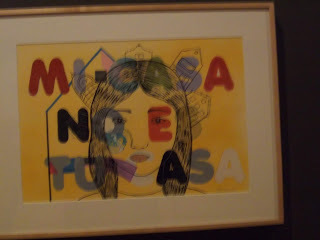 It says "My House is not Your House"The exhibit about the encroaching re-gentrification of Pilsen is political as is much of the art in the National Museum of Mexican Art is, including some of my favorite pieces in the museum. This is one of them.
It says "My House is not Your House"The exhibit about the encroaching re-gentrification of Pilsen is political as is much of the art in the National Museum of Mexican Art is, including some of my favorite pieces in the museum. This is one of them.
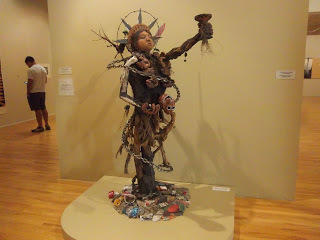
It was done years ago but expresses the anxieties of this group that have escalated since our current president was elected.
The fear and anxiety of the community is expressed also in the quietude heard and felt in the neighborhood. On previous visits, the area had always been bustling with people. On that day, it felt like a ghost town. Usually when we visit the National Museum of Mexican Art, we go to a Mexican restaurant in the neighborhood for lunch. That day we cast about for a restaurant that had some people in it.
Although there are several restaurants on 18thStreet, many looked pretty empty. The Five Rabanitos had some people eating there so we went in. The food was great. It’s a short walk from the 18thStreet stop of the Pink Line. The prices are reasonable, too. I highly recommend it if you’re in the area. Patronizing the Mexican owned businesses is a good way to support their community during these “interesting times” - and delicious, too.
One of the enjoyable things about going to the Museum is walking around Pilsen and seeing some of the wall murals and we were able to do that this time.

Since we had been to all the permanent exhibits of the museum we decided to visit its temporary one “Peeling Off the Grey.” The theme of this exhibit is the growing gentrification of Pilsen and the effects of this trend on long-time residents of the neighborhood.
Always a neighborhood of immigrants, Pilsen was first settled by Czechs and then Polish, hence its name popularly known for that brand of beer. After that in the 1940’s, Mexican-Americans began moving into the area. Self-help groups and other associations were established and many in the Mexican community adopted it as their home.
In recent years, there has been a movement afoot to "re-gentrify" parts of Pilsen. As that happens, housing prices have risen and it has pushed many long-time Mexican-American residents out of their homes. Since 2000, 10,300 residents were forced to leave their neighborhood due to rising rents. The exhibit is a cry of anguish and a protest against re-gentrification as the people in Pilsen watch their neighborhood being torn apart. It is also a reminder that we as a society need to make sure that we have enough affordable housing to keep communities intact.
 It says "My House is not Your House"The exhibit about the encroaching re-gentrification of Pilsen is political as is much of the art in the National Museum of Mexican Art is, including some of my favorite pieces in the museum. This is one of them.
It says "My House is not Your House"The exhibit about the encroaching re-gentrification of Pilsen is political as is much of the art in the National Museum of Mexican Art is, including some of my favorite pieces in the museum. This is one of them.

It was done years ago but expresses the anxieties of this group that have escalated since our current president was elected.
The fear and anxiety of the community is expressed also in the quietude heard and felt in the neighborhood. On previous visits, the area had always been bustling with people. On that day, it felt like a ghost town. Usually when we visit the National Museum of Mexican Art, we go to a Mexican restaurant in the neighborhood for lunch. That day we cast about for a restaurant that had some people in it.

Although there are several restaurants on 18thStreet, many looked pretty empty. The Five Rabanitos had some people eating there so we went in. The food was great. It’s a short walk from the 18thStreet stop of the Pink Line. The prices are reasonable, too. I highly recommend it if you’re in the area. Patronizing the Mexican owned businesses is a good way to support their community during these “interesting times” - and delicious, too.
Published on October 25, 2018 06:00
October 18, 2018
At the Precipice, I March to the Polls. Every Vote Counts.
 On March 13, I did something that I’ve done every year since I turned 21 and that’s a lot of years at this point. I marched to the polls. The difference was that this time, I had the company of many thousands of others.
On March 13, I did something that I’ve done every year since I turned 21 and that’s a lot of years at this point. I marched to the polls. The difference was that this time, I had the company of many thousands of others.Election Day is only three weeks away and we had a lot to march for. We rallied at Chicago’s Grant Park – many young and many of us veterans of decades of election days, mostly women but also men who are on our side, whites and people of color.
The marches and the rallies are important. They get us inspired to go vote, to make phone calls, to write letters, to do voter registration drives. The idea of this march was to get people psyched to go to the polls.
I marched for many reasons. I marched to be counted. I marched to serve notice that I won’t accept America's becoming a Fascist state. I marched to say that bigotry is never okay. I marched because we won’t allow this last-ditch effort by the current regime to turn back the clock on women’s rights to be successful. I marched because I don’t want the Affordable Care Act or any other parts of American’s fraying social safety net to be torn apart. I marched because I refuse to be silent.
I welcome the young women that spoke who are running for elected office for the first time and the high school and college students who spoke. I welcome all the new voters who were there and marched to the early voting sites, those who will vote on Election Day, those who will vote early in their cities and villages and those who will vote by absentee ballots.
Marching isn’t enough. With all the voter suppression going on, those of us who can vote must vote. It’s our only recourse left and we have to use it while we still have it. The march went from Grant Park to the Federal Plaza. From there it split off to two early voting sites, one for Chicago voters and one for those who live in the Cook County suburbs of Chicago. I hope that a lot of votes were cast on Saturday after the march was over.
As always in my adopted city of Chicago, I will vote early. I wish I could vote often but fortunately, even here that’s no longer allowed. So you all have to support me by voting, too.
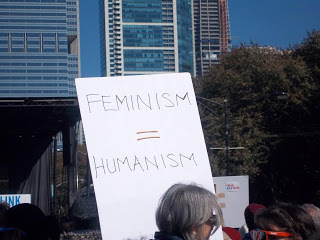
We have to vote this time. We can’t have anyone sitting this Election Day out. Ninety million people failed to vote in 2016 and that has brought America to the precipice. There is too much at stake. Your vote matters. Every vote matters. VOTE!!
In Illinois, sites will be open in various places for early voting beginning on October 22nd. If you don’t know where you can vote early, you can call your County Clerk’s office or the Board of Elections and ask.
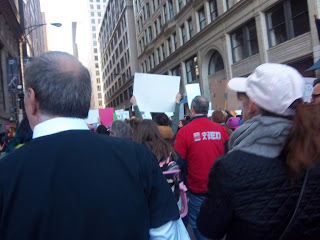
Published on October 18, 2018 06:00
October 11, 2018
Changing the Rules in the Middle of the Game, the Indians Win!!
Growing up, I always thought of Columbus Day as a day off from school that I hoped wouldn’t be used to go shopping for sales. I come from a family who always regarded bargain hunting as their favorite sport, but I was never a fan of it.
Of course, I absorbed all the myths about Columbus, the discoverer of the Americas. It wasn’t until I was an adult that I learned about his abuse of the indigenous peoples whom he “discovered.” Much later I asked myself how someone could discover a land that had already been inhabited by people for thousands of years. I had long ago reached that level of consciousness when two years ago, the city of Evanston voted to celebrate Indigenous Peoples’ Day in place of Columbus Day and so I went to many of the day’s events.
This year as before, most of the Indigenous Peoples’ Day Events took place at the Mitchell Museum www.mitchellmuseum.org. This museum houses the many native American artifacts that the Mitchells collected. It has since grown and changes its exhibits often. One can go to the museum every so often and see different things than seen on the last visit.
 Couple At Sunset by David Johns, NavahoThis is one of my favorite paintings from the Museum.
Couple At Sunset by David Johns, NavahoThis is one of my favorite paintings from the Museum.

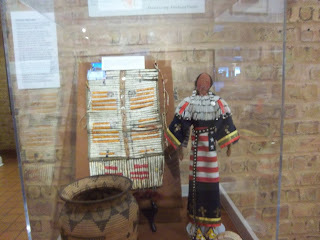 other Navaho crafts on displayMy schedule for that day didn’t allow me much time to attend events, but I felt that it was important in this era of racial animosity fueled by our current regime for all peoples especially minorities to support one another.
other Navaho crafts on displayMy schedule for that day didn’t allow me much time to attend events, but I felt that it was important in this era of racial animosity fueled by our current regime for all peoples especially minorities to support one another.I was glad that I was able to attend a story telling session presented by Ernest Whiteman, an Arapaho from Wyoming. Since the audience was primarily young children with their moms, Mr. Whiteman geared the stories to them. He told the children a story of when he was seven years old and playing cowboys and Indians by himself role playing both sides. He said not knowing that he was an Indian and thinking that Indians didn’t exist, he always let the cowboys win. His older brother walked by and watching his game, reprimanded him for allowing the cowboys to win. “After all, we’re Indians,” he said.
When Mr. Whiteman refused to believe this, his brother told him to “ask Dad.” When he asked his father if their family were Indians, his father replied, “Yes, son, we’re Arapahos.”
At that point, Mr. Whiteman learned of his ethnic identity and in effect, the Indians finally won a battle. Another Indian child was no longer lost.
In the United States today, there are over 500 tribes recognized by the United States Government and another 150 tribes awaiting that official validation. I hope that they all know who they are and are teaching it to their children. I’m glad that the City of Evanston gives children here the opportunity to know about native Americans and thus be prepared to live in our multi-cultural country.
If you didn’t attend Indigenous Peoples’ festivities this year, look for them next October. I’m sure you’ll learn something if you do go.
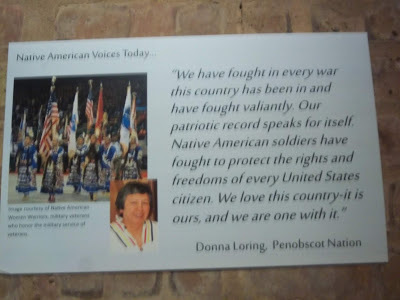
Published on October 11, 2018 08:06
September 27, 2018
A Great Ending to Summer at Touhy Beach
What can be better than art work and the beach in the same place on a beautiful summer day? For the past 25 years, the Rogers Park Community in Chicago has gotten together to create art at the beach and raise funds for community projects. Individuals, small groups, and organizations can buy sections of a long, cement bench to paint whatever their spirits move them to paint. Each spring the bench is white washed so that people can paint it again.
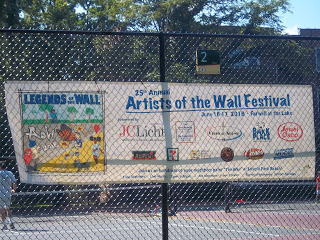 At the beginning of the wallWe’ve been going to view this great community art project every summer for the past few years but had somehow missed it this year until a week ago. I was glad to see that all our rains this summer hadn’t washed the painting away. We were able to see all the artwork in full color.
At the beginning of the wallWe’ve been going to view this great community art project every summer for the past few years but had somehow missed it this year until a week ago. I was glad to see that all our rains this summer hadn’t washed the painting away. We were able to see all the artwork in full color.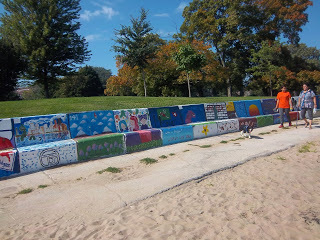 the colorful painted bench.I’m sharing some of my favorites with you so that you can get an idea of the spirit of it. As they say, one picture is worth 1000 words.
the colorful painted bench.I’m sharing some of my favorites with you so that you can get an idea of the spirit of it. As they say, one picture is worth 1000 words.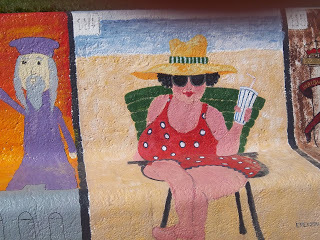
I love this picture. I've always felt that the beach is our reward here for enduring the never ending Chicago winters. This picture expresses that spirit on the beach trying to enjoy our rare moments of sun and warmth.
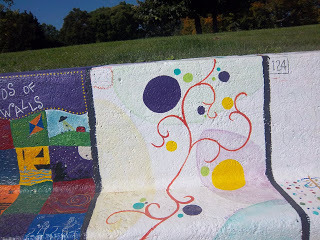 This one was very decorative and I thought beautiful.
This one was very decorative and I thought beautiful.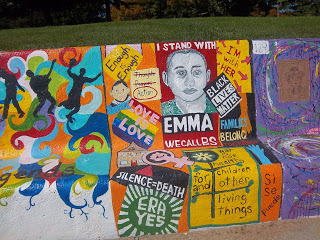 Many of the sections advocate for causes. I believe in all of the causes advocated in this section of the bench.
Many of the sections advocate for causes. I believe in all of the causes advocated in this section of the bench.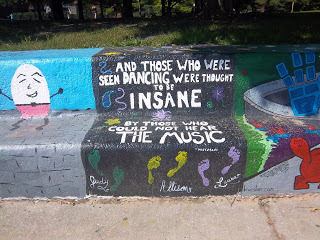 I love the spirit of this one.
I love the spirit of this one.And now sadly, summer has come to an end. I'm looking forward to next summer when the neighborhood artists will have the opportunity to express themselves in all the many ways that they choose.
Published on September 27, 2018 06:00



